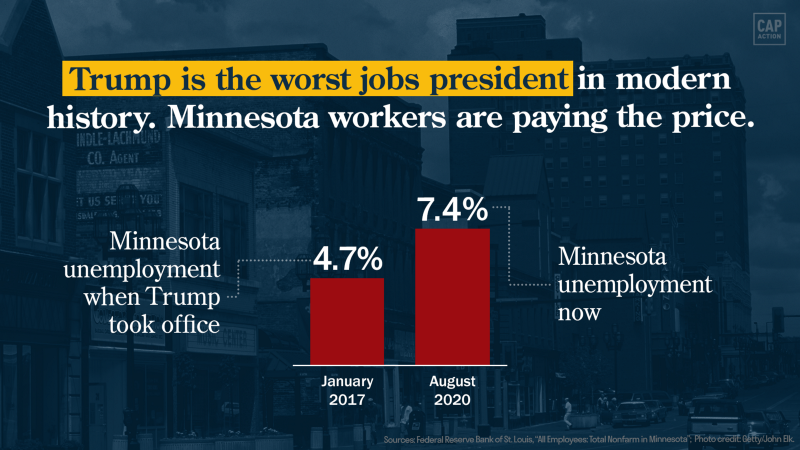
Minnesota unemployment when Trump took office: 3.8 percent
Minnesota unemployment now: 7.7 percent
Washington, D.C. — Tomorrow, President Donald Trump will arrive in Bemidji, Minnesota, to hold a rally in an airplane hanger at Bemidji Aviation Services. This appearance is just the latest in a string of examples of the president disregarding the COVID-19 pandemic, putting Americans at risk despite having known the dangers of the virus since February. Earlier this week, he held an indoor event in Arizona, violating his own administration’s coronavirus safety guidelines. The president was fined by the city of Henderson, Nevada, which hosted his rally, for similarly putting its residents at risk over the weekend. The administration’s botched handling of the pandemic, including lying to the American people about the danger it posed, has led to the deaths of more than 195,000 Americans, including more than 1,900 in Minnesota.
204,000 fewer Minnesotans are employed now than when President Trump first took office in 2017, a 7 percent percent decline. Following his refusal to properly address the COVID-19 crisis, Minnesota’s unemployment rate in July sat at 7.7 percent. Additionally, President Trump’s executive action on unemployment insurance has caused chaos in states across the country, reducing benefits by $300 per week. For perspective, a Center for American Progress analysis finds that the president’s action, if implemented, would leave a typical one-parent, one-child family in Minnesota $1,551 short of making ends meet. Meanwhile, new reports show that if the Trump-backed lawsuit to repeal the Affordable Care Act (ACA) succeeds, 337,000 state residents could lose health coverage and 2.3 million Minnesotans with preexisting conditions could face higher premiums or be barred from coverage during the pandemic.
Instead of leading the country out of the pandemic, Trump has continued his long-time assault on Social Security by calling for the termination of a large portion of its dedicated funding source: payroll taxes. Trump’s proposal, according to Chief Social Security Actuary Stephen Goss, would wipe out the Social Security Trust Fund by 2023. More than 1,053,166 Minnesota residents are Social Security beneficiaries — roughly 19 percent of the total state population.
Learn more about how the Trump administration’s policies have hurt and put Minnesota families at risk below.
Profits over wages
Promise: “We’re bringing back our jobs from other countries. We’re bringing back our companies from other countries.” — Donald Trump in Duluth, Minnesota, June 20, 2018
Reality: The Trump administration blocked a federal minimum wage increase for Minnesota workers, which has cost working families.
- 430,000 Minnesota workers were denied a pay increase.
- Minnesota workers lost $734 million in wages.
Taxes
Promise: “We want to lower your taxes. … We’re for low taxes and no crime.” — Donald Trump in Rochester, Minnesota, October 4, 2018
Reality: Most of the Trump administration’s $2 trillion tax cut goes to corporations and the rich. Many Minnesota families are getting stuck with the bill.
- 178,330 Minnesota families paid more in taxes in the first year after the Trump administration’s tax cuts.
- For the 2019 tax year, the average tax cut for the wealthiest 1 percent of Minnesotans was $36,150. The average tax cut for the middle 20 percent of Minnesotans was $870.
Dreamers
Promise: “We’re going to work something out that’s going to make people happy and proud. … [Dreamers] got brought here at a very young age, they’ve worked here, they’ve gone to school here. Some were good students. Some have wonderful jobs.” — Donald Trump, November 28, 2016
Reality: Trump assured Dreamers that they should rest easy and said he was not interested in targeting them for deportation. Yet less than one year after taking office, he ended the Deferred Action for Childhood Arrival (DACA) program. By taking away these protections, Trump put the futures of 800,000 people who arrived in the United States as children in jeopardy, along with their ability to work and contribute to their state economies.
- There are 17,500 eligible Dreamers in Minnesota, and 60,000 Minnesotans live in a household with at least one Dreamer.
- The average Dreamer in Minnesota arrived to the United States when they were 8 years old.
- Minnesota Dreamers are crucial to the state’s economy. They pay more than $126 million in federal taxes; pay more than $74 million in state and local taxes; and spend $570 million on goods and services — all of which boosts the economy.